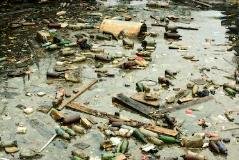Water pollution
Water pollution is defined as: “It is the contamination of water with undesirable and harmful substances.”

Polluted water has certain characteristics:
- Bad taste
- Offensive odour
- Unpleasant color
- Unchecked growth of weeds
- Oil or grease floating on surface
Sources of water pollution
- Sewage and domestic waste spread Pathogens:-
- They form the major part of pollutant. They includebacteria etc. that enter the into water bodies etc. Human excreta usually contain E.coli bacteria and streptococcus bacteria that cause lot of gastrointestinal problems.
- Organic wastes:
- It includes leaves, grass etc. it leads to excessive growth of plants in water bodies.
- The bacteria act on these waste as they are biodegradable.They consume oxygen dissolved in water and tis concentration of oxygen is very important for aquatic life.
- Both the bacteria aerobic and anaerobic have harmful effect as anaerobic bacteria breaks down the organic matter and result in the formation of chemicals that give foul smell and are harmful to human health whereas aerobic bacteria degrade the organic matter and lower the concentration of oxygen .
- Oxygen consumed by microorganism in decomposing the waste present in certain volume of sample of water is called biochemical oxygen demand (BOD) of water.
- Chemical pollutants:
- The lot of metals, chemicalsetc. are disposed in the water bodies and cause lot of harm like metals are very dangerous as we can’t excrete them therefore they can damage kidneys, CNS,liver etc. petroleum and its products also pollute water .
- The excessive disposal of chemicals in water bodies leads to eutrophication.
Eutrophication is a result of excessive disposal of chemicals that leads to excess growth of algae in water bodies that is water bloom and this water bloom results in oxygen depletion and aquatic life suffers a lot due to this effect.
Radioactive discharge: They enter the water bodies from different sources like nuclear reactions, nuclear tests etc. they emit very harmful radiations.
Polychlorinated biphenyl’s: These are used as fluids in transformers etc. They are resistant to oxidation and when released in atmosphere they cause skin disorders.
International standards of drinking water
There arecertain substances in water which are essential but only up to certain limits.They are as below:
Fluoride:
- Water should be tested for fluoride ion concentration.Its deficiency in water cause harmful diseases like tooth decay etc.The fluoride ion in water help in enamel of teeth much harder by converting hydroxyl-apatite into much harder flour-apatite.
Lead:
- The presence of increased concentration of lead can harm kidney, liver and reproductive system.
Sulphate:
- Excessive sulphate can cause laxative effect.
Nitrate:
- The maximum limit of nitrate is 50ppm. Excess nitrate cause methemoglobinemia.